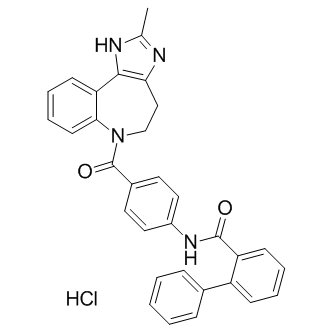| Cas No.: | 168626-94-6 |
| SMILES: | O=C(C1=CC=C(NC(C(C=CC=C2)=C2C3=CC=CC=C3)=O)C=C1)N4C5=CC=CC=C5C(NC(C)=N6)=C6CC4.Cl |
| Formula: | C32H26N4O2.HCl |
| M.Wt: | 535.04 |
| Purity: | >99% |
| Sotrage: | 2 years -20°C Powder, 2 weeks 4°C in DMSO, 6 months -80°C in DMSO |
| Description: | Conivaptan (hydrochloride) is a non-peptide antagonist of vasopressin receptor, with Ki values of 0.48 and 3.04 nM for rat liver V1A receptor and rat kidney V2 receptor respectively. |
| Target: | Ki: 0.48 nM (V1A receptor), 3.04 nM (V2 receptor) |
| In Vivo: | Conivaptan (0.03, 0.1 and 0.3 mg/kg, i.v.) dose-dependently increases urine volume and reduces urine osmolality in both myocardial infarction and sham-operated rats. Conivaptan (0.3 mg/kg i.v.) significantly reduces right ventricular systolic pressure, left ventricular end-diastolic pressure, lung/body weight and right atrial pressure in myocardial infarction rats. Conivaptan (0.3 mg/kg i.v.) significantly increases dP/dt(max)/left ventricular pressure in myocardial infarction rats[1]. Conivaptan produces an acute increase in urine volume (UV), a reduction in osmolality (UOsm) and, at the end of the investigation, cirrhotic rats receiving the V(1a)/V(2)-AVP receptor antagonist does not show hyponatremia or hypoosmolality. Conivaptan also normalizes U(Na)V without affecting creatinine clearance and arterial pressure[2]. Conivaptan (0.01 to 0.1 mg/kg, i.v.) exerts a dose-dependent diuretic effect in dogs without an increase in the urinary excretion of electrolytes, inhibits the pressor effect of exogenous vasopressin in a dose-dependent manner (0.003 to 0.1 mg/kg i.v.) and, at the highest dose (0.1 mg/kg i.v.), almost completely blocks vasoconstriction caused by exogenous vasopressin. Conivaptan (0.1 mg/kg, i.v.) improves cardiac function, as evidenced by significant increases in left ventricular dP/dtmax, cardiac output and stroke volume, and reduces preload and afterload, as evidenced by significant decreases in left ventricular end-diastolic pressure and total peripheral vascular resistance in dogs with congestive heart failure[3]. |
| Animal Administration: | At 4 weeks after the operation, 39 myocardial infarction rats survived. Thirty are randomly selected without bias and divided into five groups such that the distribution of infarct size and body weight among groups are similar, and given vehicle, conivaptan (0.03, 0.1 and 0.3 mg/kg) or SR121463A (0.3 mg/kg) by intravenous administration. Sham rats are also divided into four groups and given vehicle or conivaptan (0.03, 0.1 and 0.3 mg/kg) by intravenous administration. Rats are then placed individually in metabolic cages and urine is collected for 3 h. Urine osmolality is measured by the freezing point depression method using an osmometer. |
| References: | [1]. Wada K, et al. Intravenous administration of conivaptan hydrochloride improves cardiac hemodynamics in rats with myocardial infarction-induced congestive heart failure. Eur J Pharmacol. 2005 Jan 10;507(1-3):145-51. Epub 2005 Jan 1. [2]. Fernandez-Varo G, et al. Effect of the V1a/V2-AVP receptor antagonist, Conivaptan, on renal water metabolism and systemic hemodynamics in rats with cirrhosis and ascites. J Hepatol. 2003 Jun;38(6):755-61. [3]. Yatsu T, et al. Cardiovascular and renal effects of conivaptan hydrochloride (YM087), a vasopressin V1A and V2 receptor antagonist, in dogs with pacing-induced congestive heart failure. Eur J Pharmacol. 1999 Jul 9;376(3):239-46. |

 DC Chemicals' products qualify for U.S. tariff exemptions. We guarantee no price increases due to customs duties and maintain stable supply, continuing to deliver reliable research solutions to our American clients.
DC Chemicals' products qualify for U.S. tariff exemptions. We guarantee no price increases due to customs duties and maintain stable supply, continuing to deliver reliable research solutions to our American clients.





















